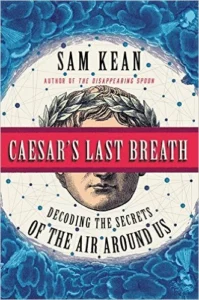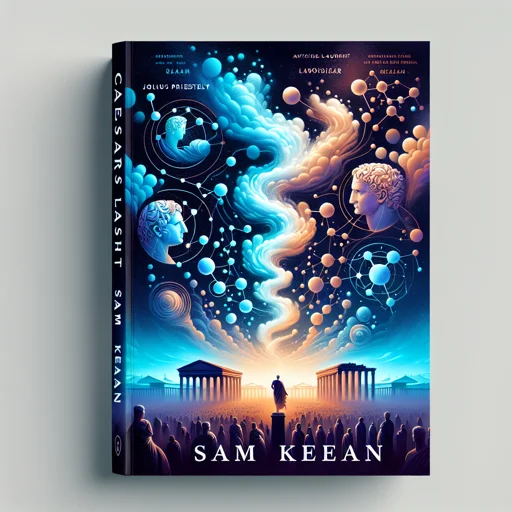Summary of ‘Caesar’s Last Breath’ by Sam Kean: A Detailed Synopsis

Introduction
What is Caesar’s Last Breath about? This book explores the science and history of the air we breathe. Author Sam Kean combines humor and fact, showing how even the simplest gas has a profound story. From ancient times to today, every breath connects us to those before us, including Julius Caesar.
Book Details
- Title: Caesar’s Last Breath
- Author: Sam Kean
- Published: July 18, 2017
- Pages: 384
- Genres: Science, Nonfiction, History, Chemistry, Popular Science
Synopsis of Caesar’s Last Breath
Introduction to Caesar’s Last Breath
Sam Kean’s *Caesar’s Last Breath* reveals a fascinating subject: the invisible air around us. This book takes readers on a unique expedition through history and science. Kean captures the connection between the air we breathe and significant moments in history. With every inhale, we absorb molecules that have been present since the dawn of life. From Julius Caesar’s last breath to particles from cosmic events, each breath holds a story. Kean’s wit and engaging style make complex scientific concepts accessible. His ability to intertwine historical anecdotes makes the reading experience enjoyable. This book is not just about gas; it’s an exploration of humanity’s relationship with this essential element.The History of Air
This book opens with a tale from March 15, 44 BC. On this fateful day, Julius Caesar was assassinated. According to Kean, you may just inhale a fraction of the air he expelled in his final moments. This idea sets the stage for exploring the air’s role in historical events. Throughout history, gases have influenced the Earth and human civilization. The narrative unfolds with stories of ancient scientists who unraveled the mysteries of the atmosphere. It covers how air formed amid volcanic eruptions and how it evolved over eons. Kean provides vivid accounts of scientists like Joseph Priestley and Antoine-Laurent Lavoisier. Their groundbreaking work on gases, particularly oxygen, laid foundations for modern science. Kean highlights major advancements in understanding our atmosphere. The tales include accidental discoveries, dramatic experiments, and even catastrophic explosions. For instance, he recounts the eruption of Mount St. Helens. The eruption not only reshaped the landscape but also wreaked havoc on human life.Intriguing Gas Stories
Diving deeper, *Caesar’s Last Breath* presents remarkable stories about gases. Kean serves up tales of radioactive pigs and bizarre performance artists like Le Pétomane at the Moulin Rouge. The infamous flatulist became one of France’s most esteemed entertainers, illustrating the intersection of science and entertainment. The book doesn’t shy away from darker narratives. Kean details the development of chemical warfare in World War I. The story of Fritz Haber—a scientist who produced fertilizer and poison gas—brings a sobering contrast. Despite his Nobel Prize-winning contributions, his work had catastrophic consequences. Every chapter introduces various gases and their impact. From harmless laughing gas to the deadly mustard gas of warfare, the book scrutinizes their roles. It provides a comprehensive look at how gases interact with human lives and the environment.The Future and Climate Change
As the narrative unfolds, Kean’s gaze shifts towards our future. He offers insights into climate change and humanity’s ongoing battle with this crisis. With rising carbon emissions, he poses critical questions about the viability of our planet. Kean proposes radical engineering solutions, like dispersing silver iodide in the atmosphere. While most ideas generate intrigue, they raise concerns about their implications. This introspective look at our actions provides a cautionary tale for future generations. The latter parts of the book also speculate about life beyond Earth. Kean discusses the potential for terraforming other planets in our solar system. As humanity seeks new frontiers, the exploration of gaseous conditions on exoplanets becomes crucial.Conclusion: The Richness of Air
*Caesar’s Last Breath* thrives on blending humor with scientific inquiry. Kean’s storytelling invites readers to appreciate the richness of the air we often take for granted. By relating shocking, funny, and tragic instances throughout history, he brings the air to life. The book ultimately highlights the interconnectedness between air, history, and our future. It encourages a deeper appreciation for the invisible forces at work around us. This engaging read is perfect for science enthusiasts and casual readers alike. Whether you’re seeking laughs, insights, or profound reflections, you’ll find a wealth of information in this book. Sam Kean successfully demystifies the science of gases while keeping it entertaining. After reading, you may never look at a simple breath the same way again.From here you can jump to the Spoilers section right away.
Below you can search for another book summary:
Alternative Book Cover

Quotes
- “In a scene right out of Catch-22, the construction firm requested the “best” iron available for some components. Little did they know that the foundry sold three grades of iron ingots: best, best best, and best best best.”―Sam Kean,Caesar’s Last Breath: Decoding the Secrets of the Air Around Us
- “the navy brought an ark’s worth of animals to Bikini and distributed them among the target ships, to test the biological effects of atomic bombs. After this was announced, several thousand angry letters poured into U.S. government offices. Ninety people even volunteered to take the animals’ places, including the writer E. B. White and a prisoner in San Quentin who said he wanted to do society some good for a change.”―Sam Kean,Caesar’s Last Breath: Decoding the Secrets of the Air Around Us
- “Every molecule in our bodies started off life as a gas, and long after our demise, when the big red bloated sun swallows everything around us, all those atoms will return to a gaseous state.”―Sam Kean,Caesar’s Last Breath: Decoding the Secrets of the Air Around Us
You want to give Caesar a try? Here you go!
Characters
- Sam Kean: The author, a skilled storyteller and science writer, connects complex ideas with humor and anecdote.
- Julius Caesar: Iconic Roman leader whose last breath connects readers to a distant past, suggesting we share airtime with history.
- Le Pétomane: A comical flatulist who became a celebrity at the Moulin Rouge, illustrating the oddities of human entertainment.
- Fritz Haber: A pivotal chemist who transformed air into fertilizer, then turned it into poison gas in World War I.
- Harry Truman: An old man who refused to evacuate before the eruption of Mount St. Helens; he was vaporized by the blast.
- Antoine-Laurent Lavoisier: A key figure in chemistry who helped discover oxygen, ultimately executed during the French Revolution.
- Joseph Priestley: Another chemist credited with isolating oxygen, whose life was marred by public discord and riots.
- Alfred Nobel: Inventor of dynamite; he later founded the Nobel Prize to counterbalance his contributions to warfare.
- James Watt: The innovator whose steam engine revolutionized industry and urban life, forever changing society’s structure.
- Lord Rayleigh & William Ramsey: Discoverers of noble gases, helping to enrich the periodic table with essential elements.
Highlights
- Air is Life: Every person shares molecules with historical figures, connecting us through breaths.
- Interesting Anecdotes: Kean mixes facts with stories, from volcanic eruptions to fabled entertainers.
- Scientific Discoveries: The book depicts pivotal discoveries, such as the isolation of gases and their applications.
- Human Impact: Kean discusses how gases impact our environment and contribute to climate change.
- Future Speculations: He ends with thoughts on space exploration and terraforming as humankind’s next frontier.
Spoilers
FAQs about Caesar’s Last Breath
What is the core theme of the book?
The interplay between the gases we breathe and their historical significance.
Why should I read this book?
It offers a fun and engaging look at science combined with real historical narratives.
Is this book suitable for science novices?
Yes, Kean writes in an accessible manner, ideal for all reading levels.
What genres does this book belong to?
It’s a mix of science, nonfiction, and history.
Where can I purchase this book?
Available at most bookstores and online platforms.
Reviews
For a deeper exploration of Caesar’s Last Breath and its pros and cons, visit our full review.
Are you looking for a nice read that perfectly fits your current mood? Here is a free book suggestion tool. It gives you suggestions based on your taste. Also a likelihood rating for each recommended book. Would you like to find the book you will love later or now?
About the Author
Sam Kean is a prominent science writer based in Washington, D.C. His work spans various topics, aiming to make science accessible and entertaining.
Are you looking for a nice read that perfectly fits your current mood? Here is a free book suggestion tool. It gives you suggestions based on your taste. Also a likelihood rating for each recommended book. Would you like to find the book you will love later or now?
Conclusion
We hope you found this synopsis of Caesar’s Last Breath engaging. Summaries serve as gateways to richer understanding. If what you’ve read excites you, the full book awaits with even more wonders.
DISCLAIMER: This book summary does not replace the original work. If you are the original author and wish for removal, please contact us.










